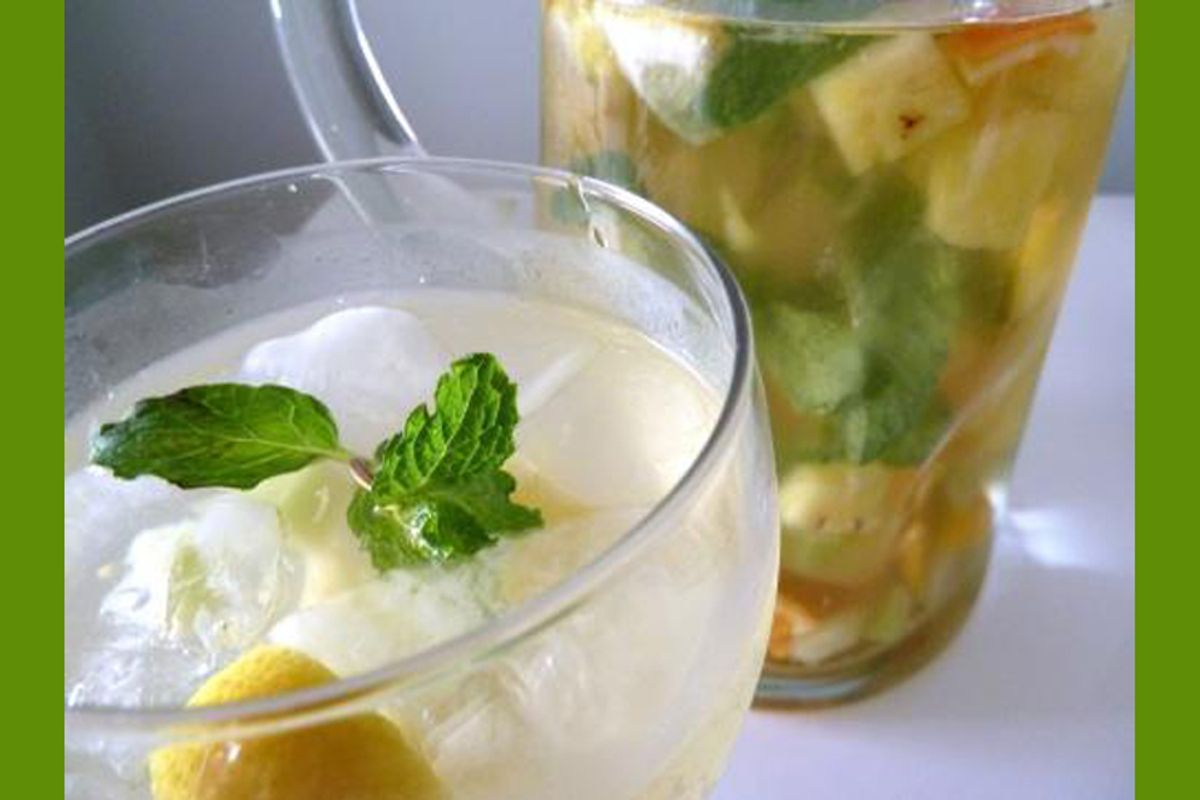Sangria, that much loved wine punch, is all about family. While in the States sangria is a popular drink in restaurants, especially in tapas bars, in its native Spain and Portugal, only a tourist would try to order it in a bar. Where sangria was invented, it's a summer drink to enjoy with family and friends at home, and each family has its own "official" recipe.
In Providence, R.I., where I went to college, there is a large Portuguese community. These families come mainly from the Azores, the enchanted islands off continental Portugal, and Cabo Verde, the African islands formerly governed by Portugal. While many of the campus' neighbors were Portuguese speaking, the closest most students would ever get to being familiar with Portuguese culture would be the weekly walk down to Wickenden Street to Daily Bread for the poufy round loaves of pão doce (Portuguese sweet bread). We'd tear it off in large chunks, eating it like it was cotton candy.
I was lucky to get a closer taste. My "in" was one of my college suitemates, Diane, who grew up not 20 minutes from campus in neighboring Pawtucket. Despite the geographic proximity, the cultural distance between her world and our dorm was so vast, she could have been in the Azores, where her parents came from. Diane did not comprehend the foreign ways of many students on campus, with their drinking games at frat parties and fleeting casual relationships. As the first member of her family to attend college, Diane studied and worked hard during the week, but made no pretense that her real life was anywhere but in her community. She went home every weekend, to her life of Catholic feasts, Portuguese festas, and home-cooked meals of caldo verde, linguica and homemade pão doce.
"Diane não está," her Grandmother would answer when any one of us reached her on their home phone. Diane's grandmother never learned to speak English, but she would recognize when any of Diane's non-Portuguese-speaking friends would call from school and would automatically tell us that Diane was out.
We'd occasionally get a glimpse into Diane's world, when one of us had a car and could drive to meet her at her family's multigenerational, multilevel home on the weekend. While waiting for Diane, we'd sit across from her grandmother and smile, and she'd smile back. She'd offer us her handcrafted pão doce, and it was lemony and dense -- nothing at all like the fluffy stuff we bought in town, and infinitely better. Her home and family were simple, but their bonds were strong, and traditions even stronger.
Diane was the first of my friends to get married, shortly after college graduation. Her former suitemates were invited to the big event. It was a festive affair with scores of relatives and friends so close they were called family. The tables in the simple catering hall were covered with baskets of Portuguese rolls and bottles of Portuguese wine, including the white wine known as vinho verde, literally "green wine." I thought that the "verde" referred to the color of the wine. What I learned is that vinho verde refers specifically to wine from the Minho region in the far north of Portugal, which is described as a largely rural paradise, lush with greenery. Some say that the verdant scenery gave rise to the name of the local wine. More often, the green in the name is credited to the youth and freshness of the wine, and not its color.
The food at the reception, kilos and kilos of it, included the classic caldo verde (kale and potato soup), bacalhau (salted codfish) and a stew of pork and clams. The food was flavorful, the company warm, and the party festive. Amazingly, Diane's proud father cooked the entire meal, enough for 300, to keep a promise to her. He managed to do this despite his failing health. Sadly, he died shortly after the wedding.
In honor of my Portuguese friend Diane, and the strong bonds of family she shared with me, I am mixing a sangria with vinho verde. Like other white sangrias, it's the lighter, less intense sibling of the sangria family. Vinho verde makes it special because of its citrus notes and gentle natural effervescence. To play on the "verde" in this wine's name, I've added sprigs of fresh mint. This sangria verde is perfect for warm summer evenings with family and friends. It is the perfect accompaniment to an appetizer of figs and goat cheese (queijo de cabra) drizzled with honey.
Saúde!
Green Sangria
Makes 1 pitcher
Ingredients
- 1 bottle vinho verde
- 2 cups ginger ale
- ½ cup Cointreau
- 1 bunch fresh mint
- 1 lime, seeded and cut into wedges
- 1 lemon, seeded and cut into wedges
- ½ small orange, seeded and cut into wedges
- ½ cup cubed pineapple
- ½ cup cubed honeydew melon
Directions
- Place all prepared fruit into a pitcher.
- Pour the vinho verde, Cointreau and 1 cup of ginger ale over the fruit.
- Wrap tightly with plastic wrap and chill in refrigerator overnight to allow flavors to mingle.
- Just before serving, add a sprig of mint and add with the remaining cup of ginger ale to the pitcher.
- Serve over ice, with as much of the fruit as desired. Make sure not to add ice to the pitcher directly or you'll dilute the sangria.



Shares